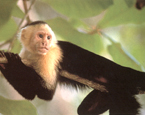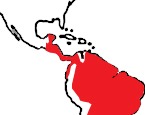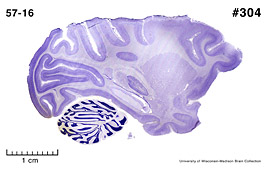|
White-headed Capuchin (Cebus)
(Cebus capucinus) #57-16 |
||||
|
|
Physical
characteristics and distribution
|
|
Head and body length is 305-565 mm, the tail is 300-560 mm.
Weights of adults range from 1,100 - 3,300 g. White markings
on the face, throat and chest are characteristic of C. capucinus,
coloration elsewhere ranges from yellowish gray to grayish brown.
The tail is well haired and slightly prehensile, often slightly
curled at the tip. |
|
Description
of the brain
|
|
Animal
source and preparation
|
|
All
specimens collected followed the same preparation
and histological procedure.
|
Other Related Resources (websites and publications)
List of Specimens | Explore Collections | Brain Sections | Brain Evolution | Brain Development | Brain Circuitry | Brain Functions | Location and Use | Related Web Sites | Contact Us | Search MSU Database | Personnel | Home



